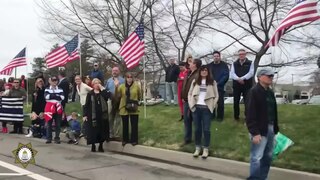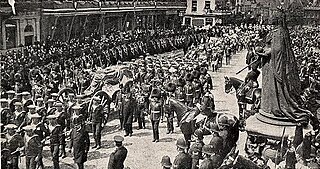The article's lead section may need to be rewritten.(June 2024) |
Women have had varying roles in the death care industry in the United States since its mid-nineteenth century inception.
The article's lead section may need to be rewritten.(June 2024) |
Women have had varying roles in the death care industry in the United States since its mid-nineteenth century inception.
The funeral industry in America emerged after the Civil war as a means of disposing of the countless bodies that were accumulated during the war. [1] Prior to this, care of the sick and recently deceased was largely done at home by women. [1] However, the Civil War led to the need to transport many bodies long distances from their place of death to the final resting place, and thus to the common practice of embalming bodies. [2] Due to the chemicals required in the embalming process professionals were needed to care for North America's deceased. [2] As time progressed caring for the deceased transitioned from being a practice performed in the home to an extremely profitable industry. [1]
During the early development of the funeral industry, undertaking became one of the few trades that allowed women to participate during a time when the business world predominately consisted of “landowning, educated, white men.” [1] Although women were not prohibited from entering the death service industry they were rarely given the position of undertaker unlike their male counterparts. [1] During the Victorian era, women were only allowed to care for the bodies of women and children due to the time period’s strict enforcement of propriety. [3] In addition to this fact “the further the funeral industry headed toward becoming a profession, the further women were left behind.” [1] To further exclude women from the funeral industry, Civil War-era trades journals, for instance, The Casket and Embalmer’s Monthly, published articles to discourage women from entering the trade. [3]
In the late nineteenth century, Lina D. Odou pioneered and advocated for women’s involvement in embalming. [1] Odou is quoted as saying, "Over and over again have I heard mothers ask undertakers if they could not furnish women embalmers for their dead daughters, and many others to whom the dead are sacred have asked the same question, and I have invariably heard such men say there are no women to be had for such a purpose." [1] The lack of female embalmers, due to social stigma, motivated Odou to become an expert in the field by studying in Switzerland; and later in 1899 she opened an institute for women at the undertaking establishment of the Reverend Stephen Merritt. [1] Odou's first class graduated 10 students. [1] She established the Lina D. Odou Embalming Institute in 1901. [3]
Small family owned funeral homes are still in practice, although large specialist organizations managing funerals have gained prominence due to societal and technical changes and the institutionalization of death. [4] “The funeral industry is laden with sexism and specific roles based on sex.” [5] During the 1960s and 1970s, there was a stigma against females as funeral directors that lasted until 1980; it was extremely difficult for women to find employment in the funeral industry outside of a family practice. [6]
Women have recently[ when? ] started to regain prominence in the funeral industry, as more than half (57%) of mortuary science students are women. [7] Funeral homes such as White Lady Funerals have a staff completely composed of women. [5]

A funeral is a ceremony connected with the final disposition of a corpse, such as a burial or cremation, with the attendant observances. Funerary customs comprise the complex of beliefs and practices used by a culture to remember and respect the dead, from interment, to various monuments, prayers, and rituals undertaken in their honour. Customs vary between cultures and religious groups. Funerals have both normative and legal components. Common secular motivations for funerals include mourning the deceased, celebrating their life, and offering support and sympathy to the bereaved; additionally, funerals may have religious aspects that are intended to help the soul of the deceased reach the afterlife, resurrection or reincarnation.

Burial, also known as interment or inhumation, is a method of final disposition whereby a dead body is placed into the ground, sometimes with objects. This is usually accomplished by excavating a pit or trench, placing the deceased and objects in it, and covering it over. A funeral is a ceremony that accompanies the final disposition. Evidence suggests that some archaic and early modern humans buried their dead. Burial is often seen as indicating respect for the dead. It has been used to prevent the odor of decay, to give family members closure and prevent them from witnessing the decomposition of their loved ones, and in many cultures it has been seen as a necessary step for the deceased to enter the afterlife or to give back to the cycle of life.

Embalming is the art and science of preserving human remains by treating them to forestall decomposition. This is usually done to make the deceased suitable for viewing as part of the funeral ceremony or keep them preserved for medical purposes in an anatomical laboratory. The three goals of embalming are sanitization, presentation, and preservation, with restoration being an important additional factor in some instances. Performed successfully, embalming can help preserve the body for many years. Embalming has a very long and cross-cultural history, with many cultures giving the embalming processes religious meaning.

A funeral director, also known as an undertaker or mortician, is a professional who has licences in funeral arranging and embalming involved in the business of funeral rites. These tasks often entail the embalming and burial or cremation of the dead, as well as the arrangements for the funeral ceremony. Funeral directors may at times be asked to perform tasks such as dressing, casketing, and cossetting with the proper licences. A funeral director may work at a funeral home or be an independent employee.

The ancient Egyptians had an elaborate set of funerary practices that they believed were necessary to ensure their immortality after death. These rituals included mummifying the body, casting magic spells, and burials with specific grave goods thought to be needed in the afterlife.

Roman funerary practices include the Ancient Romans' religious rituals concerning funerals, cremations, and burials. They were part of time-hallowed tradition, the unwritten code from which Romans derived their social norms. Elite funeral rites, especially processions and public eulogies, gave the family opportunity to publicly celebrate the life and deeds of the deceased, their ancestors, and the family's standing in the community. Sometimes the political elite gave costly public feasts, games and popular entertainments after family funerals, to honour the departed and to maintain their own public profile and reputation for generosity. The Roman gladiator games began as funeral gifts for the deceased in high status families.
Disposal of human corpses, also called final disposition, is the practice and process of dealing with the remains of a deceased human being. Disposal methods may need to account for the fact that soft tissue will decompose relatively rapidly, while the skeleton will remain intact for thousands of years under certain conditions.

In death customs, a viewing is the time that family and friends come to see the deceased before the funeral, once the body has been prepared by a funeral home. It is generally recommended that a body first be embalmed to create the best possible presentation of the deceased. A viewing may take place at the funeral home's chapel, in a family home or at a place of worship, such as a church. Some cultures, such as the Māori of New Zealand, often take the body to the marae or tribal community hall.

Natural burial is the interment of the body of a dead person in the soil in a manner that does not inhibit decomposition but allows the body to be naturally recycled. It is an alternative to typical contemporary Western burial methods and modern funerary customs.

Embalming chemicals are a variety of preservatives, sanitising and disinfectant agents, and additives used in modern embalming to temporarily prevent decomposition and restore a natural appearance for viewing a body after death. A mixture of these chemicals is known as embalming fluid and is used to preserve bodies of deceased persons for both funeral purposes and in medical research in anatomical laboratories. The period for which a body is embalmed is dependent on time, expertise of the embalmer and factors regarding duration of stay and purpose.
The death care industry in the United States includes companies and organizations that provide services related to death: funerals, cremation or burial, and memorials. This includes for example funeral homes, coffins, crematoria, cemeteries, and headstones. The death care industry within the U.S. consists mainly of small businesses, although there has been considerable consolidation over time.
Neglect is defined as giving little attention to or to leave undone or unattended to, especially through carelessness. Mortuary neglect can comprise many things, such as bodies being stolen from the morgue, or bodies being mixed up and the wrong one was buried. When a mortuary fails to preserve a body correctly, it could also be considered neglect because of the consequences.

Thomas Greenhill (1669?–1740) was a surgeon who worked in London and was also author of a book Νεκροκηδεία or The Art of Embalming on embalming. He was also surgeon to Henry Howard, 7th Duke of Norfolk. He was born after the death of his father, William Greenhill, the last of 39 children born to Elizabeth Greenhill.
The Funeral Rule, enacted by the Federal Trade Commission on April 30, 1984, and amended effective 1994, is a U.S. federal regulation designed to protect consumers by requiring that they receive adequate information concerning the goods and services they may purchase from a funeral provider.

A funeral procession is a procession, usually in motor vehicles or by foot, from a funeral home or place of worship to the cemetery or crematorium. In earlier times the deceased was typically carried by male family members on a bier or in a coffin to the final resting place. This practice has shifted over time toward transporting the deceased in a hearse, while family and friends follow in their vehicles. The transition from the procession by foot to procession by car can be attributed to two main factors; the switch to burying or cremating the body at locations far from the funeral site and the introduction of motorized vehicles and public transportation making processions by foot through the street no longer practical.
Edgar Ray Butterworth was an American funeral director, believed to have coined the professional terms mortuary and mortician.

Deathcare is the planning, provision, and improvement of post-death services, products, policy, and governance. Here, deathcare functions to describe the industry of deathcare workers, the policy and politics surrounding deathcare provision, and as an interdisciplinary field of academic study.

The funeral directors to the Royal Household of the Sovereign of the United Kingdom are selected and appointed by the Lord Chamberlain's Office.
A Home funeral is when a funeral occurs at a person's home, as opposed to a funeral home. Though rare since the advent of funeral homes, they were once common events, since washing and laying out the body often took place at home, as well as the viewing, the wake and the burial in the family plot. Some are now preferring to do this themselves.
James E. Reveley was an American mortician, dentist, and consumer advocate for the regulation of the American funeral industry. Through the 1970s, he helped push the Texas Legislature to overhaul the funeral industry's oversight body, eliminate antiquated laws requiring embalming, and pass ground-breaking legislation to protect grieving consumers from exploitative practices. Following his success in Texas, Reveley continued his fight at the national level helping the Federal Trade Commission's Funeral Rule overcome industry opposition and survive congressional veto, transforming the way the funeral industry operates nationwide.